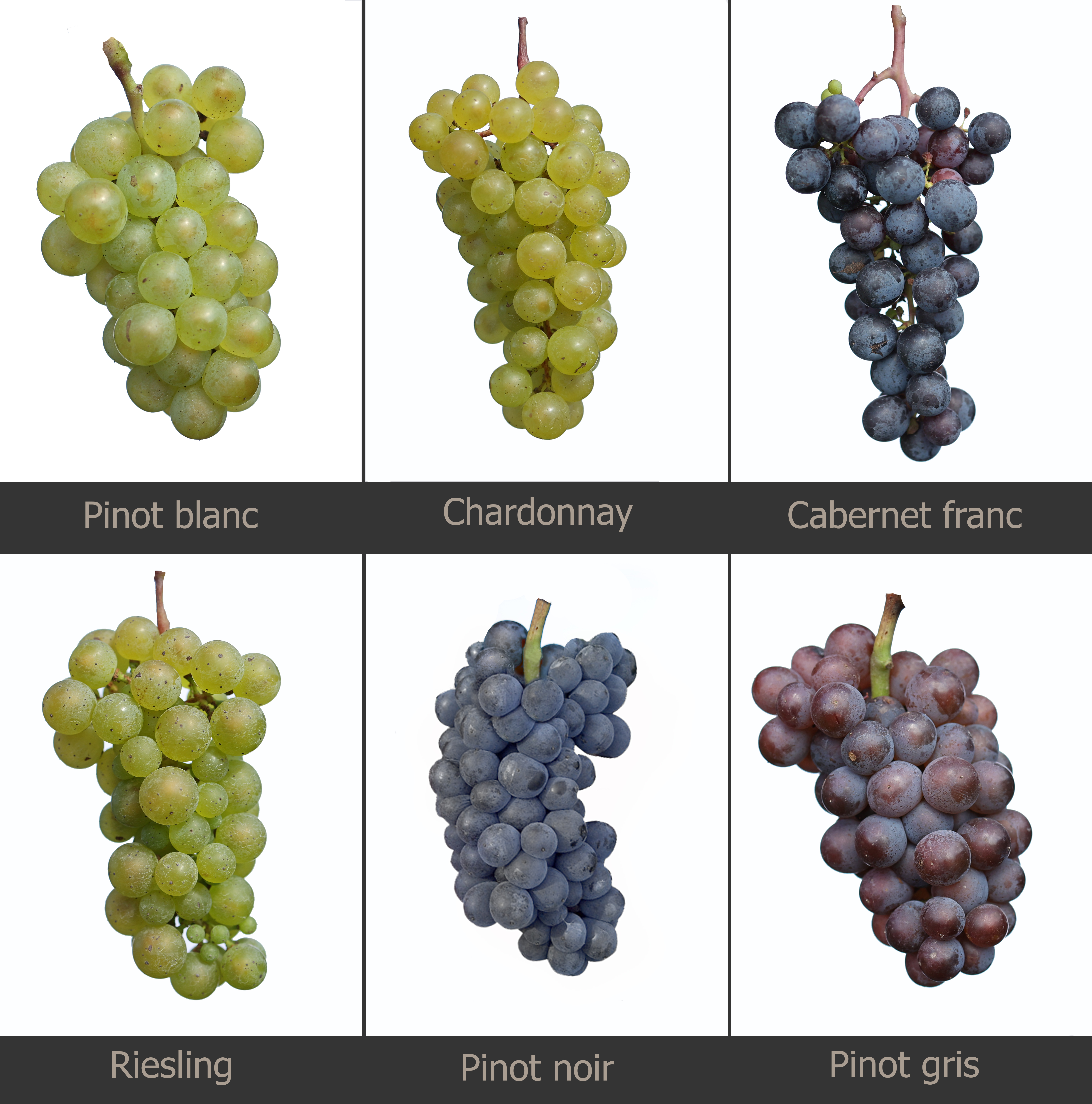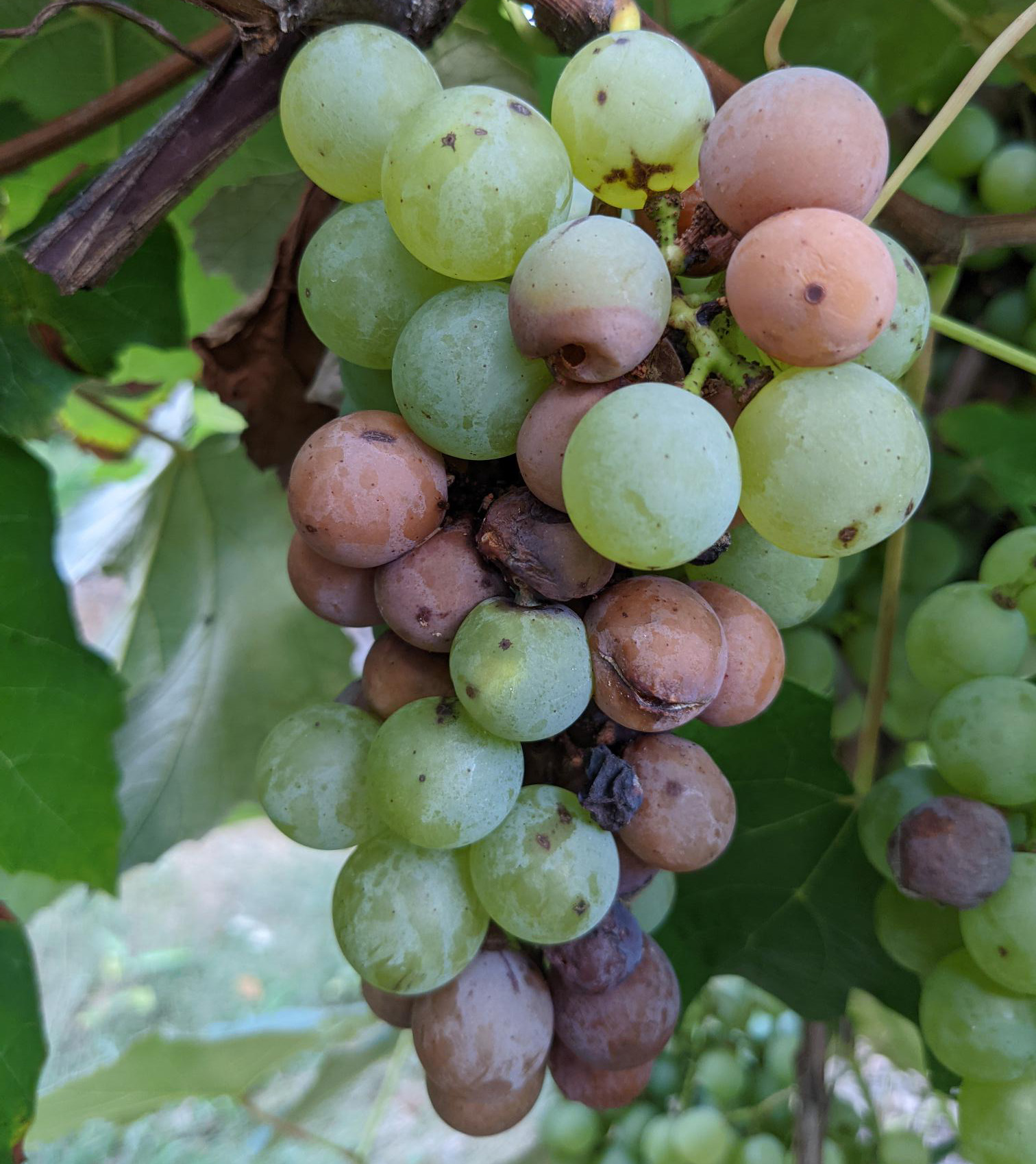Michigan grape scouting report – Sept. 15, 2021
Sugar levels are increasing in wine and juice grapes, but acid levels are still high.

Weather
Last week started cool. High temperatures were in the mid-70s, lows were in the 50s. A cold front pushed through the state on Tuesday that was accompanied by a strong line of storms. All grape growing areas of Michigan saw rain from this line of storms. Most areas saw around half an inch of rain. Parts of southwest Michigan reported pea-sized hail and up to 3 inches of rain.
Moderate heat returned by the end of the week for southwest Michigan with temperatures in the mid-80s. Cooler temperatures remained for the rest of the state. Southeast portions of the state saw another round of storms on Sunday and Monday with an additional inch of rain.
This next week should be warmer than the last. Highs in southern Michigan will be in the mid to upper 80s, lows in the 60s. Northern parts of the state will be 5-10 degrees cooler. A chance of rain is expected for parts of the state on Friday. Otherwise, it should be a dry week.
With the diverse week around the state, we picked up a wide range of growing degree days (GDD), 83-125 GDD base 50. The southwest region is 600 GDD base 50 ahead of the northwest region.
|
Northwest Michigan GDD summary from March 1 – Sept. 13, 2021 | |
|---|---|
|
Northwest stations |
GDD 50 F |
|
Petoskey (Petoskey) |
2037 |
|
Traverse City (NWMHRC) |
2233 |
|
Old Mission (Old Mission) |
2172 |
|
Average for northwest region |
2119 |
|
Average last week |
2036 |
|
Southern stations |
|
|
Benton Harbor (SWMREC) |
2786 |
|
Lawton (Lawton) |
2738 |
|
Fennville (TNRC) |
2522 |
|
Average for southwest region |
2718 |
|
Average last week |
2593 |
|
Romeo (Romeo) |
2616 |
|
Average for southeast region |
2647 |
|
Average last week |
2536 |
Vine growth
In southwest Michigan, harvest is expanding this week. Early hybrid wine grapes continue to be picked. White vinifera varieties are now being harvested as well.
In the northern vineyards, Chardonnay and Pinot Noir are beginning to harvest for sparkling production. In almost all of the grape cultivars, veraison is completed and they are reaching good sugar concentration.
|
Variety |
Northwest region (Brix) |
Southwest region (Brix) |
|---|---|---|
|
Riesling |
15.7 |
19.7 |
|
Chardonnay |
18.3 |
Not available |
|
Pinot noir |
18 |
Not available |
|
Pinot Blanc |
17.8 |
21.2 |
|
Cabernet Franc |
14.3 |
Not available |
|
Zweigelt |
15 |
Not available |
|
Madel.Ang. |
18.2 |
Not available |
|
Pinot Gris |
18.1 |
20.2 |
|
Gewurztraminer |
Not available |
22.0 |
|
Gruner Veltliner |
Not available |
17.8 |
|
Muscat Blanc |
Not available |
19.2 |
|
Noiret |
Not available |
18.7 |
|
Regent |
Not available |
19.5 |
|
Concord |
Not available |
15.9 |
|
Niagara |
Not available |
16.1 |

Horticulture
During fruit maturation, bird damage can be a challenge in vineyards. Crop losses can reach up to 95% and 60% in red and white varieties, respectively. Several methods of protection can be implemented including the use of bird nets, streamers, scare-eye balloons, electronic bird distress calls and propane-fired bird-scaring cannons. For more information on these methods, see: bird damage reduction strategies in viticultural practices.
This time of the season it is pivotal to properly monitor fruit chemical characteristics and maturity to make precise decisions on time of harvest and winemaking strategies to produce the best quality wine possible from this vintage. High quality wines are the natural convergence of fruit-derived flavor and aroma with ad hoc winemaking technologies. Therefore, in deciding the picking time for grapes, the priority needs are the quality and quantity of varietal aroma and flavor in the fruit. Sampling fruit in the vineyard regularly will describe aromas, flavors and textures for each different cultivar. that each cultivar goes through.
The next priority for red wines is the texture of the grape tannins in the skin and the seed because they determine the structure, body, astringency, bitterness and color intensity of the wine. Brix or sugar content is a simple way to determine a ripeness scale but the levels can greatly vary from year to year. In some years the grapes will be ripe with perfect varietal character at 21 brix and another year they may not have a varietal character at 23 brix.
Weeds
Weed control is important at this time of the year to reduce weed interference in machine or manual harvest and to reduce the soil weed seed bank for the following season.
The application timing for most of the herbicides before harvest is mainly based on the pre-harvest interval (PHI). Aim (three-day PHI), Rely (14-day PHI), and Gramoxone (Restricted Use Pesticide) provide quick burn-down of weeds. Rely and Gramoxone control both broadleaves and grasses, but Aim is only effective for broadleaves. Venue (zero-day PHI) can be added to improve burn-down and broaden the weed control spectrum. Some herbicides will damage grape green bark, new shoots, leaves or vines, so minimize contact with vines during application.
Glyphosate also has a short 14-day PHI, but it is not advisable to apply it after bloom. Significant injury may occur during the current season or the following year if glyphosate comes in contact with leaves, green shoots or is absorbed by bark.
Detailed information related to the herbicide rates and efficacy on weeds can be obtained in the Herbicide section of E154 Michigan Fruit Management Guide, which contains lists of all currently labeled herbicides along with specific remarks for their use in vineyards.
Diseases
Since many parts of the state are past veraison, the main diseases to focus on are bunch rots including botrytis and sour rot. Botrytis is becoming more common around the state. Several strategies contribute to good botrytis bunch rot management including opening up the canopy, effective insect control, properly applying fungicides, and using resistant cultivars when possible. Good botrytis control depends on getting good coverage. Just before bunch closure is the last chance to apply a fungicide to the inner part of the developing cluster. The most effective products for botrytis are site specific and prone to resistance development. A Michigan Grape Fact Sheet is available for managing botrytis bunch rot.
We have also been seeing sour rot in some vineyards in southwest Michigan. It is usually characterized by clusters that smell like vinegar, juice that drips over the fruit surfaces, a melting-type decay with skin slippage, and vinegar flies and fly larvae typically present. Recent research has shown a significant correlation between insect activity and sour rot movement. These insects have been primarily vinegar flies, but at MSU we have observed yellow jackets, honey bees and bald-faced hornets on sour rot clusters. Recent research into a well-timed insecticide at 14 Brix along with a sterilant (e.g., Fracture or Oxidate) prior to sour rot symptoms is an effective method of control.

Another disease to not forget about is downy mildew. This disease is causing particular trouble for growers this year. The recent waves of rain and high humidity have created good conditions for repeated infection events. If they are permitted, fungicides that are broad-spectrum/contact like captan are effective products for resistance management. Viticultural practices that reduce canopy wetness such as good irrigation timing, leaf removal and good weed management can reduce these diseases in a vineyard.
The main concern with downy mildew at this time is late season defoliation. So far this season we have observed downy mildew more frequently than normal due to the high relative humidity and longer dew periods. Defoliation will impact winter hardiness and survival, as well as health of the vine next year. Effective fungicides for downy mildew include products in FRAC codes 4, 11, 21, 40 and 45 as well as phosphorus acid salts, captan and some biologically-based products.
Insects
Larvae of a fourth generation of berry moth have been developing in recent weeks in some hotspots, helped by the early season and warm weather. Catches of the moths declined in monitoring traps this week indicating that the forth flight is ending.
Wasps and bees are becoming common in vineyards. They are attracted to the accumulating sugars in the berries. Yellow jackets can be very damaging to the berries directly, causing wounds that can lead to cluster rots and reducing harvestable crop. They can also be frustrating to sprayers and harvest crews, trying to avoid being stung while working with the ripening grapes. Picking in cooler weather can help avoid wasp stings, but it is challenging to reduce their abundance with sprays at this time of the year due to the difficulty in controlling all wasps in a nest. Interception of wasps using traps deployed at the vineyard border can help reduce their abundance if the traps are placed at a high enough density.
Vinegar flies are starting to increase in abundance as more berries ripen and some fall from the vine or are opened by other insects or birds. These typical vinegar flies can develop on grapes only when the skin is broken, but with the presence of the invasive spotted wing drosophila in Michigan it is more important to keep a regular check on clusters for development of vinegar flies in berries.
Management of berry quality after veraison and treatments for sour rot (see above) can help reduce the impacts of vinegar flies. The presence of vinegar flies in the canopy can be easily determined by disturbing the clusters, as the small flies will take off and be seen around the clusters.
Presence of fly larvae in berries can be determined by putting fruit into a gallon bag with half a pint of salt solution (1 cup per gallon) for an hour, then looking in the solution to determine whether there are larvae present. If treatment is needed, there are several shorter PHI insecticides available that can provide temporary protection from SWD and other vinegar flies, including Mustang Maxx, Leverage and Verdepryn.
Related articles
- Southwest Michigan Fruit Update – September 7, 2021
- A Mobile Guide for Grape IPM Scouting in North Central and Eastern U.S.
- Mid-season management of grape berry moth
- Michigan grape scouting report – September 1, 2021
- Pest management approaches in a winter or freeze damaged grape vineyard
- Bird damage reduction strategies in viticultural practices
- What can be done for late season downy mildew in grapes?



 Print
Print Email
Email